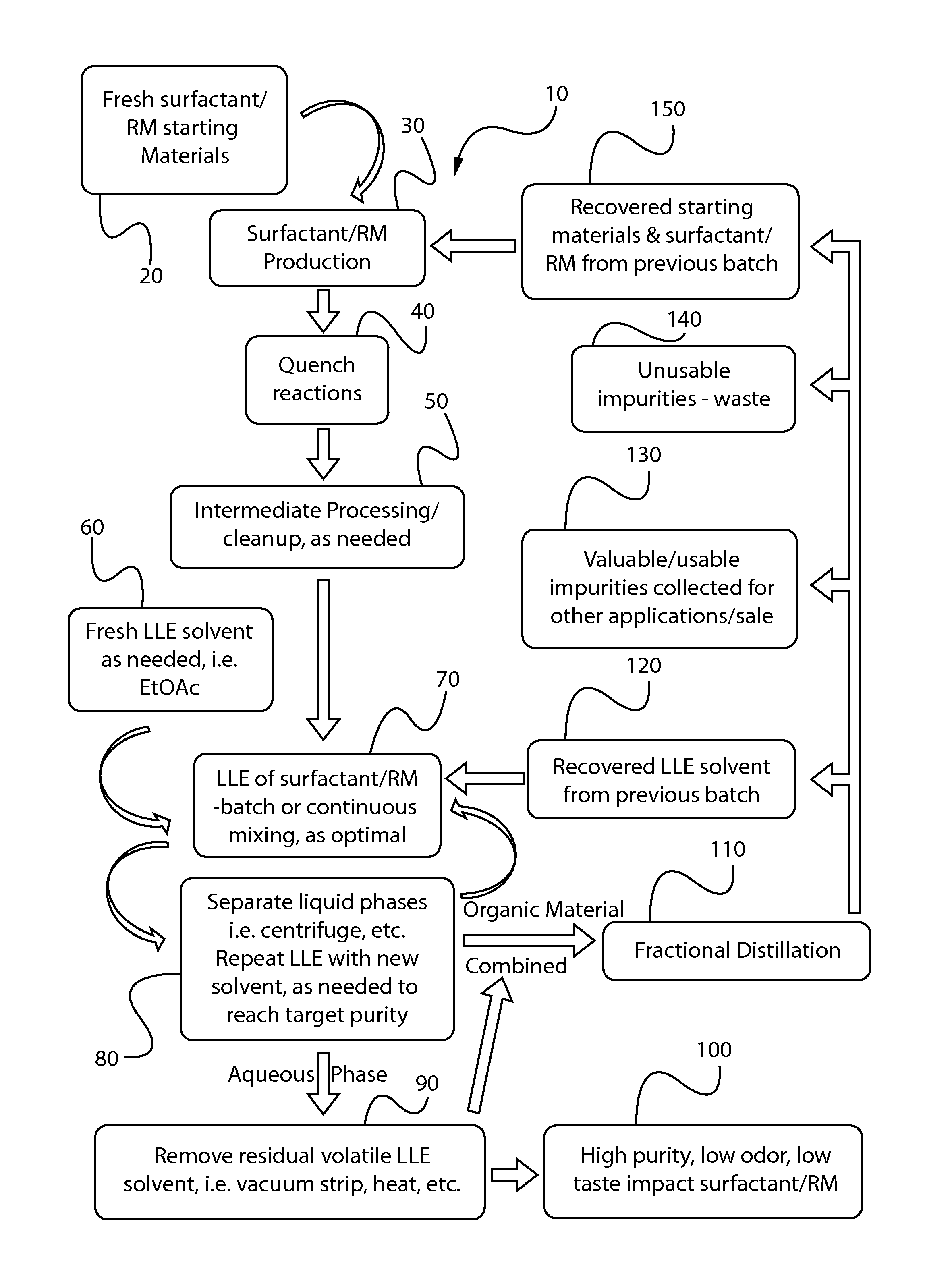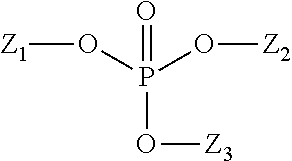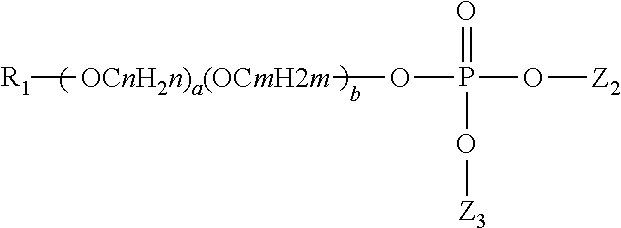Process for surfactant taste and/or odor improvement
a technology of surfactant and taste, applied in the field of watersoluble surfactant compositions, can solve the problems of bitterness, soapy and the like of materials, and achieve the effect of improving consumer acceptance and improving the taste of water-soluble surfactants
- Summary
- Abstract
- Description
- Claims
- Application Information
AI Technical Summary
Benefits of technology
Problems solved by technology
Method used
Image
Examples
example i
Improved MAP L213 / S Surfactant
[0159]Undesirable non-polar materials were extracted from MAP L213 / S (a mono alkyl phosphate surfactant in aqueous solution, see Table 1 above), supplied by Rhodia, using the processes set forth herein wherein ethyl acetate (supplied by Honeywell Burdick & Jackson, Muskegon, Mich., USA) was used as the extraction solvent. The extracted materials were then analyzed and the treated MAP L213 / S was evaluated for taste and odor after the extraction and shown to be very mild, especially when compared with the starting MAP L213 / S material. The undesirable materials removed from the ML213 / S commercially supplied material are set forth in Table 3, below. The following process steps were taken:
1. 100 grams of MAP L213 / S were placed into a clean 250 mL separatory funnel.
2. 100 mL of ethyl acetate was added to the separatory funnel, which was stoppered, and shaken vigorously for approximately 1 minute.
3. The separatory funnel contents were then rested for a period ...
example ii
Improved Cocoamidopropyl Betaine Surfactant
[0171]Undesirable non-polar materials were extracted from cocoamidopropyl betaine surfactant, supplied by Stepan, Mexico SA DE CV (Matamoros, MX), using the process steps shown in Example I, except that 20 grams cocoamidopropyl betaine and 20 mL of solvent were used (in place of 100 grams of MAP and 100 mL of solvent) and only 3 repetitions (stages) of steps 2 through 5—substituting the cocoamidopropyl betaine for the MAP L213 / S. The extracted materials were then analyzed and the treated cocoamidopropyl betaine surfactant was evaluated for taste and odor after the extraction and shown to be very mild, especially when compared with the starting material. The undesirable materials removed from the commercially supplied material are set forth in Table 5, below.
[0172]
TABLE 5Cocoamidopropyl Betaine - Pre and Post 3 Stages of EtOAc ExtractionControlPostAreaRetention(Pre-ExtractReduc-Timeextract)PeaktionImpurity(Min)Peak AreaArea(%)—————Cyclohexyl...
example iii
Improved Lauryl Betaine Surfactant
[0173]Undesirable non-polar materials were extracted from lauryl betaine surfactant, supplied by Mason Chemical Company (Arlington Heights, Ill., USA), using the process steps shown in Example I, substituting the lauryl betaine for the MAP L213 / S and only four repetitions of steps (stages) 2 through 5 were completed. The extracted materials were then analyzed and the treated lauryl betaine surfactant was evaluated for taste and odor after the extraction and shown to be very mild, especially when compared with the starting material. The undesirable materials removed from the commercially supplied material are set forth in Table 6, below.
[0174]
TABLE 6Lauryl Betaine - Pre and Post 4 Stages of EtOAc ExtractionControl (Pre-AreaRetentionextract)Post ExtractReductionImpurityTime (Min)Peak AreaPeak Area(%)Dodecene Isomer4.142686070100.0Dodecene Isomer4.252690990100.0Dodecene Isomer4.361001430100.0Dodecene Isomer4.422493010100.0Dodecene Isomer4.512106910100....
PUM
| Property | Measurement | Unit |
|---|---|---|
| volumes | aaaaa | aaaaa |
| volumes | aaaaa | aaaaa |
| temperature | aaaaa | aaaaa |
Abstract
Description
Claims
Application Information
 Login to View More
Login to View More - R&D
- Intellectual Property
- Life Sciences
- Materials
- Tech Scout
- Unparalleled Data Quality
- Higher Quality Content
- 60% Fewer Hallucinations
Browse by: Latest US Patents, China's latest patents, Technical Efficacy Thesaurus, Application Domain, Technology Topic, Popular Technical Reports.
© 2025 PatSnap. All rights reserved.Legal|Privacy policy|Modern Slavery Act Transparency Statement|Sitemap|About US| Contact US: help@patsnap.com



